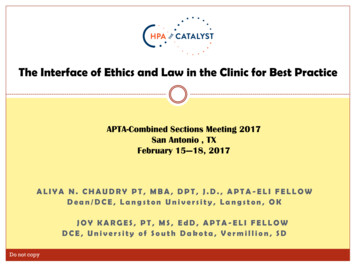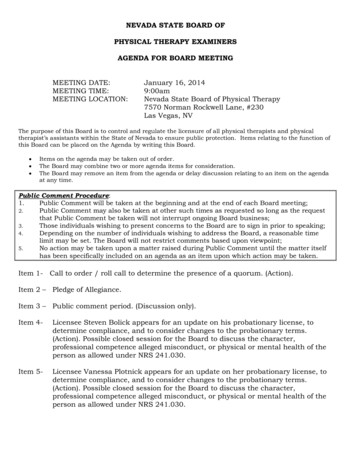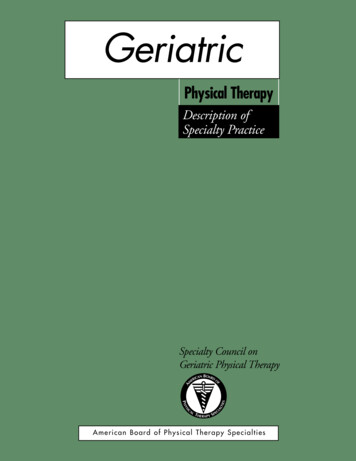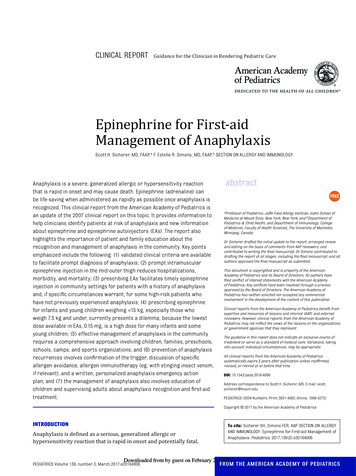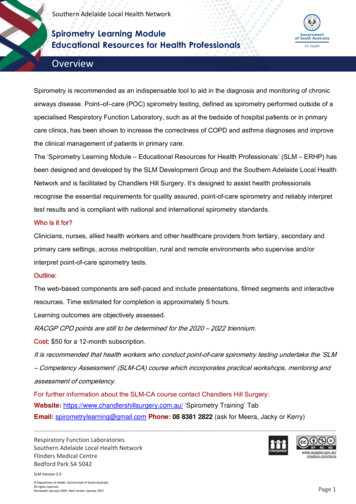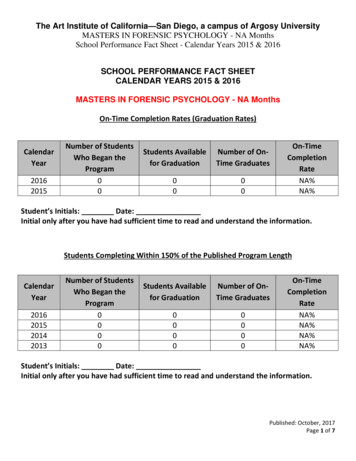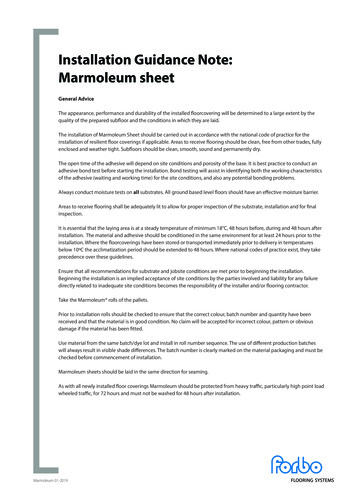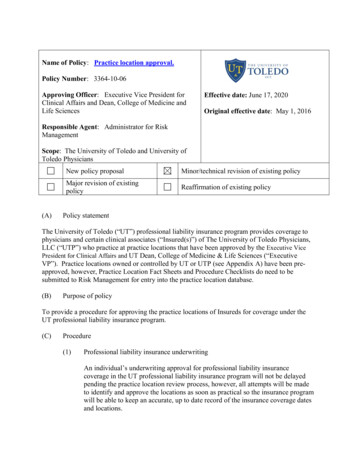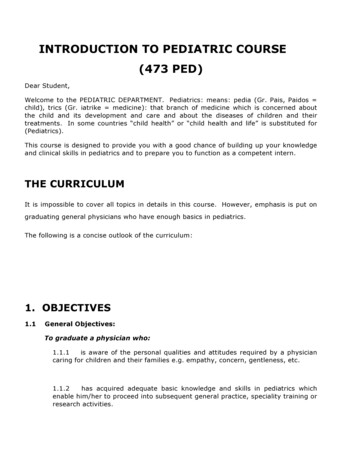
Transcription
FACTSHEETFoundations of Pediatric OrthoticsThe goal of this fact sheet is to provide a reference highlighting key points of orthoticmanagement in children. Additional information on pediatric orthotic management canbe located in the Atlas of Orthoses and Assistive Devices, edited by the American Academy of Orthopedic Surgeons, and Lower Extremity Orthotic Intervention for the PediatricClient in Topics in Physical Therapy: Pediatrics, edited by the American Physical TherapyAssociation.What Is an Orthosis?An orthosis is an external device with controlling forces to improve bodyalignment, improve function, immobilize the injured area, prevent orimprove a deformity, protect a joint or limb, limit or reduce pain, and/orprovide proprioceptive feedback. Orthoses are named for the part of thebody they cover. Orthoses can be custom molded and custom fitted(custom fitted from prefabricated orthoses or off the shelf). Orthoses areclassified as durable medical devices (DME) and require L-codes forinsurance reimbursement. A prescription signed by a physician is usuallyrequired for insurance reimbursement for custom-molded and custom-fitorthoses.Who Designs and Provides Orthoses? Certified orthotists have formal education in biomechanics and material sciences required in designing custom devices. They are nationally board certified, and 11 states require licensure to provide customdevices. There are approximately 3,000 certified orthotists in the US,with a limited number of orthotists specializing in pediatrics. Pediatricorthotists evaluate the child, cast the child, modify the mold, fabricatethe orthosis, and custom fit the orthosis to the child. Physical therapists are trained in the function of orthoses and willfrequently fit and measure orthoses. If the child is measured by thephysical therapist, the orthoses are usually centrally fabricated and returned to the therapist for custom fitting and delivery. Following delivery of the orthosis, physical therapists provide education and functionaltraining to the child and family. Some physical therapists fabricate andfit low-temperature orthotic devices/splints, requiring training beyondtheir basic education. Physicians, orthotists, and physical therapists often provide simple,off-the-shelf devices for acute situations. The sizing of these devices isdetermined by measurement and does not require custom fitting. Families can purchase supports and braces at pharmacies and sportstores.Section on Pediatrics, APTA1111 North Fairfax StreetAlexandria, Va 22314-1488Phone 800/999-2782, ext. 3254Fax capta.org
Who Is on the Team?A team approach is always recommended for optimaloutcomes. The rehabilitation team should includephysicians, orthotists, physical therapists, occupationaltherapists, social workers, and, most importantly, thechild and family. Physical therapists working with thechild and family in schools and community rehabilitation settings play an integral role in developing theorthotic prescription. Orthoses may be initially fabricated to providemaximum stability and then be adjusted for lessstability and more voluntary control as the childprogresses. Designs and colors have greatly improved wearingadherence by allowing the child to personalize andhave a choice in designing the orthosis.Diagnosis, prognosis, short- and long-term goals,home environment, occupation, recreation, age,height, weight, and prior orthotic experience(s) shouldall be discussed among the rehabilitation team whendetermining which devices are most appropriate forthe child’s current and future needs. Considerationsinclude cost as well as adjustability of the device tomeet the child’s changing needs.Materials There are numerous types and thicknesses of materials to choose from when fabricating an orthosis.Selection of brace design and the appropriatematerial and design of the brace is essential forfunction, strength, durability, flexibility, comfort,adjustability, compliancy, hygiene, and skin integrity.What Are the Characteristics of PediatricLower-Extremity Orthoses? Most orthoses are made from vacuum-moldedthermoplastics. Plastic thicknesses can varybetween 1/16” to ¼”. Occasionally, metal/leatherdesigns are appropriate. Carbon graphite/acrylic resin will increase thestrength and decrease the bulk of an ankle foot orthosis (AFO); however, these materials are not asadjustable or durable to abrasion as thermoplastics.Design Lower-extremity orthoses are specifically designedfor the child’s functional needs, whether ambulatory or non-ambulatory, with considerations of3-point force systems and ground reaction forcesto control alignment in all 3 planes. Additional benefits of orthoses may include controlling or limiting joint movements, simulating aneccentric or concentric muscle function, increasing range of motion, and providing proprioceptive feedback. This is achieved by incorporatingmechanical joints, springs, or flexible materialsinto the orthotic design.StrapsStrap designs vary depending on the need: Chafe and loop designs optimize stability, but maybe more difficult to don and have high bulk. Figure-eight ankle straps have good control andmoderate bulk.Transverse rotation control of the lower extremities (hips, knees, tibial torsion) requires the childto wear torsion cables or metal uprights with a hip/waistband/belt or elastic twister straps and waistbelt. Layover straps provide minimal stability andminimal bulkLower-extremity devices should optimize leveragefor control without resisting desired range of motion for activities or causing internal complications(eg, peroneal nerve palsy).Straps help align and hold the limb in the orthosis andmay have direct contact with the limb. Straps shouldfit securely and not gap between the plastic orthosisand the child’s limb. This increases stability anddecreases unnecessary pressure.Continued on page 32Foundations of Pediatric Orthotics
Continued from page 2Pads Pads are often provided in areas where there areboney prominences. They are used to support andcushion these areas of concern. The fit of the shoe can affect orthotic function. Theclinician can assist the child and family in selecting the proper shoe for the prescribed orthosis. The heel height of the shoe can affect the child’sstanding alignment while in the brace.Pads may be applied in an orthosis after fabrication or after physiologic changes occur. The padsare applied to increase the 3-point force systems inorder to improve alignment. Pads should never be applied in an area of thebrace that is already providing excessive pressureto the child. Even the softest padding will increasethe pressure in this area.Trim Lines The length of the footplate of an orthosis may varydepending on the child’s need: Full-length footplate (to end of toes) toprovide resistance to keep the knee frombuckling, or with utilization of a toeextensor pad for hypertonia, painful MTPjoint, or if toes have a tendency to curl. Trimming the footplate to stop behind thetoes (sulcus) is indicated to allow anormal third rocker (MTP dorsiflexion) andoften allows easier shoe donning. Trimming the footplate to stop behind MTheads (rare in children) is indicated forpainful MT heads. Full-length footplates may be designed with thinplastic or the plastic may be thinned after fabrication to allow more dorsiflexion flexibility in thethird rocker.Trim lines should optimize leverage for controlwithout adding bulk to make clothing or shoe wearhard to fit over the device.What Type of Shoes Should Be Worn With anOrthosis? Shoes should have: Good construction, leather preferred Good heel counter, quality sole A removable insole to increase instep depth ¼”–⅜” heel height Rockered toe Laces or Velcro closure to instepCan an Orthosis Be Used for ContracturePrevention/Reduction? Dynamic assistive braces have an adjustable tension-spring assistance mechanical joint to reduceor prevent anatomical joint contractures. Static progressive braces hold a stretch with theforce applied to the anatomical joint. Increasedrange may be achieved with increased manualstretch. Static braces have no adjustability and hold thelimb in one position. Custom-made braces provide optimal control in all3 planes of motion. These are indicated for longterm implications and multiple-plane control. Off-the-shelf braces provide adequate controlin one plane of motion. There are options forpurchase or rental of some braces. They are lessdurable than custom made and indicated for acuteconditions of limited range of motion. Acute conditions with soft-end ranges and goodskin integrity benefit from off-the-shelf styles. Chronic conditions or certain situations (eg, hightone/spasticity, soft-to-hard end ranges, good topoor skin integrity, a child who has periods of being agitated) should be fitted with custom braces.The cost advantage is beneficial in these situationscompared to multiple serial casts. Other interventions for control also should be considered (eg, serial casting, anti-spasticity medications, electrical stimulation). Adherence of the device regimen is essential forsuccess.Section on Pediatrics, American Physical Therapy Association3
Lower-Extremity Orthoses and Indication in the Gait CyclePhoto of the orthosisDevice &ConditionStance Phase(Indications)Swing Phase(Indications)Foot Orthosis (FO)Arch alignmentnoneUCBL,Stabilizes foot/ankleUniversity of California complex in sagittal andBiomechanicstransverse planesLaboratoryPlantar fasciitis,excessive pronation,metatarsus adductusSupra MalleolarOrthosis (SMO)Severe pronationor supinationPosterior Leaf Spring(PLS) Ankle FootOrthosis (AFO)Stabilizes foot/anklecomplex in sagittal andtransverse planesFlexible posteriorallows simulatedeccentric contractionof pre-tibial musclesDrop foot, peronealto prevent foot slap. Apalsy with minimal toUCBL foot plate willno medial or lateraloffer medial and lateralinstability(M/L) foot and anklestabilityArticulating Ankle Foot Simulated eccentricOrthosis (AAFO) with contraction of predorsiflexion (DF)tibial muscle to preventfoot slap. ProvidesAssists joints with DF. good transverse andMild drop foot withmedial lateral stabilitymedial and lateralof the foot and ankleinstabilitycomplex. Allows DFand advancement of thecontralateral limb4noneResists excessiveinversion/eversion(for safer initial contact)Swing clearanceSimulated concentriccontraction of pre-tibialmusclesProvides transverseand medial and lateralstability of the foot andankle complexFoundations of Pediatric Orthotics
Articulating Ankle Foot Encourages kneeOrthosis (AAFO) with flexion moment atplantar flexion (PF) stop initial contact throughmidstance. ProvidesToe walking, mildtransverse and M/Lto moderate genustability of the foot andrecurvatum, moderateankle complex. Allowsto severe M/LDF and advancement ofinstabilities of foot/the contralateral limbankleSwing phase clearanceSolid Ankle FootOrthosis (SAFO)Encourages kneeflexion moment ininitial contact tomid-stance. Resistsexcessive knee flexionand ankle DF. ProvidesM/L stability of the footand ankle complexSwing phase clearanceEncourages kneeextension moment toprevent knee forwardbuckling. Provides M/Lstability of the foot andankle complexSwing phase clearanceFloor Reaction AnkleDecreases the crouchFoot Orthosis (FRAFO) gait and keeps torsofor crouch gaitvertical and centerof mass in middleLower-level paraplegia of the foot. Providesassociated with hiptransverse and M/Land knee flexionstability of the foot andcontracturesankle complexSwing phase clearanceSevere hypertonia,severe rheumatoidarthritis of foot andankleFloor Reaction AnkleFoot Orthosis (FRAFO)with the foot in neutralslight plantar flexionWeak quadricepsmuscles with no M/Lknee instability5Provides transverse andmedial/lateral stabilityof the foot and anklecomplexProvides transverse andM/L stability of the footand ankle complexMore difficult going uphillsProvides transverse andM/L stability of the footand ankle complexFoundations of Pediatric Orthotics
Knee Ankle FootOrthosis (KAFO)AFO section providesM/L stability of theankle, swing phasecontrol, ground reactionforces on the knee.Knee joint & thighextension provide M/Lknee support. Lockedknee joints optionprovides maximalsagittal plane supportbut unlock for sittingSwing phase clearanceSwing phase clearanceParaplegiaMaximum support forlower extremities inall 3 planes and lowertorsoReciprocating GaitOrthosis (RGO) HipKnee Ankle OrthosisMaximum support forlower extremities andlower torsoSwing phase clearanceLow thoracic/high lumbar levelparaplegia, severe kneehyperextension, M/Linstability at the knee,Blounts diseaseHip Knee Ankle FootOrthosis (HKAFO)Mid-thoracic to highlumbar paraplegiaM/L stability for theknee in preparation forinitial contactPrevents scissoringAssists in advancementof the lower limbsPhoto courtesy of Liberating TechnologiesStanding-Walking andSitting Hip Orthosis(SWASH)TMLow to moderateadductor tonePrevents scissoring.Allows for sitting.Stabilizes the hip postsurgicallyPicture from www.camphealthcare.comLegg-Calf-Perthes6Encourages properblood flow to thefemoral neck and headFoundations of Pediatric Orthotics
REFERENCESBuckon CE, Thomas SS, Jakobson-Huston S, MoorM, Sussman M, Aiona M. Comparison of three anklefoot orthosis configurations for children with spastic hemiplegia. Developmental Med Child Neurol.2001;(43):371-378.Freeman D, Orendurff M, Moor M. Case study: improving knee extension with floor-reaction ankle-footorthoses in a patient with myelomeningocele and 20degree knee flexion contractures. J Prosthet Orthot.1999;11(3):63-68.Hsu J, Michael J, Fisk J. AAOS Atlas of Orthoses andAssistive Devices. 4th edition. St Louis, MO: Mosby;2008.Lucareli PRG, Lima MO, Lucarelli JGA, Lima FPS.Changes in joint kinematics in children with cerebralpalsy while walking with and without a floor reactionankle-foot orthosis. Clin. 2007;62(1):63-68.Martin K. Effects of supramalleolar orthoses onpostural stability in children with Down Syndrome.Developmental Med Child Neurol. 2004;(46):406-411.Selby-Silverstein L. Lower extremity orthotic intervention for the pediatric patient. In: American PhysicalTherapy Association, eds. Topics in Physical Therapy:Pediatrics, Vol 2. Alexandria, VA: American PhysicalTherapy Association; 2008:9.1-9.17.WEB SITESSurestep–Dynamic Stabilizing System:www.surestep.netUltraflex: www.ultraflexsystems.comCascade DAFO: www.cascadedafo.comFor More Information:If you have additional questions, would like to order additional copies of this fact sheet, or would like to jointhe Section on Pediatrics, please contact the Executive Office of the Section on Pediatrics of the AmericanPhysical Therapy Association at: APTA Section on Pediatrics, 1111 North Fairfax Street, Alexandria, VA22314, pediatrics@apta.org, www.pediatricapta.org. Copyright 2009. Developed by the Practice Committee of the Section on Pediatrics, APTA, with specialthanks to expert contributors Karl Barner, LPO, and Colleen Coulter-O’Berry, PT, DPT, MS, PCS, ofChildren’s Healthcare of Atlanta.Section on Pediatrics, APTA1111 North Fairfax StreetAlexandria, Va 22314-1488Phone 800/999-2782, ext. 3254Fax capta.orgSection on Pediatrics, American Physical Therapy Association7
management in children. Additional information on pediatric orthotic management can be located in the Atlas of Orthoses and Assistive Devices, edited by the American Acad - emy of Orthopedic Surgeons, and Lower Extremity Orthotic Intervention for the Pediatric Client in Topics in Physical Therapy: Pediatrics,
